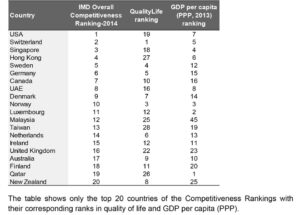
Country competitiveness and perceptions about the quality of life it offers
The executive survey employed in the development of the IMD world competitiveness ranking entices executives to reflect about the level (whether they consider it high or low) of their country’s quality of life. Intuitively one may conclude ex ante that the GDP of a particular country determines its quality of life. And yet, as we will observe shortly, GDP cannot fully explain certain patterns in the data.
The correlation between GDP/quality of life is confirmed by some of the top 10 countries of the overall competitiveness ranking. Switzerland and Norway place in the top 10 of the competitiveness ranking, life quality criterion, and in terms of GDP PPP per capita (please note that GDP ‘rankings’ refer only to countries included in the World Competitiveness Yearbook). Other top 10 countries in both competitiveness and life quality are Canada, Denmark, Germany and Sweden; they, however, fall outside the top 10 GDP (16th, 14th, 15th and 12th respectively).
Executives residing in other top 10 competitiveness countries, however, find the quality of life in those countries in need of enrichment; for example, the USA ranks first in competitiveness but emerges in the 19th position in quality of life. Similarly, Singapore ranks third and 18th, while both the USA and Singapore are in the top 10 GDP. Hong Kong and UAE experience similar patterns. Conversely, there are countries achieving high scoring in the quality of life but lower rankings in competitiveness. Austria ranks 22nd in overall competitiveness but second in life quality, Australia ranks 17th and ninth while both counties are top 10 GDP. Outside the top 10 GDP, we observe similar patterns. The Netherlands ranks 14th in competitiveness while placing sixth in life quality, New Zealand ranks 20th and eight, Spain ranks 39th and 21st and Greece ranks 57th and 40th.µ

Such trends indicate that there are other underlining elements that contribute to the quality of life. These factors include a healthy environment, the individuals’ ability to meet their “material” expectations (e.g., access to specific goods and services), life satisfaction (e.g., ability to enjoy family time), levels of equality (e.g., gender equality) and absence of threats (e.g., effective policies against crime and protection of individual rights). A test (not shown) of the relationship between the quality of life and gender inequality, for example, shows that indeed gender inequality is statistically significant in explaining the quality of life.
Research Information & Knowledge Hub for additional information on IMD publications
With stagnant import volumes since 2021, and import prices at levels below those suggested by fundamentals, foreign exporters face an uphill battle to convert access to the Chinese market into revenues. Notably, the volume stagnation predates the ...

Early in his career, Dolf van den Brink, CEO of Heineken since 2020, did everything he could to project an image of authority – including wearing spectacles he didn't need. It wasn't until he learned to be comfortable in his skin that he began to ...
It has become conventional wisdom to view Europe as an economic powerhouse past its prime, overshadowed by the steady advance of the US and meteoric rise of China. Critics cite Europe’s shrinking share of global GDP, excessive regulation, and slug...
Now in its eighth year, the 2024 IMD World Digital Competitiveness Ranking measures the capacity and readiness of 67 economies to adopt and explore digital technologies as a key driver for economic transformation in business, government, and wider...
The UAE has been making waves recently in the technology world. A $1.5 billion deal between American tech giant Microsoft and Abu Dhabi’s AI champion,G42, seems to mark a shift in global alliances. This deal is significant not just in terms of the...

Michael Wade and Tomoko Yokoi explain how IMD ranked the world's leading companies on AI adoption and use – and reveal which topped the list.

A balanced assessment of the past eight years is that, in terms of trade policy, America has turned protectionist, implementing significant measures to restrict domestic market access to foreign (non-US) imports.
Inflows of foreign direct investment into China shows worrying trends despite its massive economy. While total FDI appears substantial at $163B in 2023, most growth comes from existing foreign subsidiaries rather than new entrants. Foreign manufac...
Climate change, geopolitical frictions, and supply chain disruptions call for more sustainable trade practices that can withstand the pressures of volatility. But for trade to be sustainable, it must also be resilient. IMD World Competitiveness Ce...
The idea of an EU bond, a common safe asset, has been gaining attention lately, particularly following calls for its introduction this month by former Italian prime minister Mario Draghi.
Research Information & Knowledge Hub for additional information on IMD publications
Research Information & Knowledge Hub for additional information on IMD publications
Research Information & Knowledge Hub for additional information on IMD publications
IMD World Competitiveness Center Report, 14 November 2024, 8th edition
Research Information & Knowledge Hub for additional information on IMD publications
Research Information & Knowledge Hub for additional information on IMD publications
Research Information & Knowledge Hub for additional information on IMD publications
Research Information & Knowledge Hub for additional information on IMD publications
Research Information & Knowledge Hub for additional information on IMD publications
Research Information & Knowledge Hub for additional information on IMD publications
Research Information & Knowledge Hub for additional information on IMD publications

